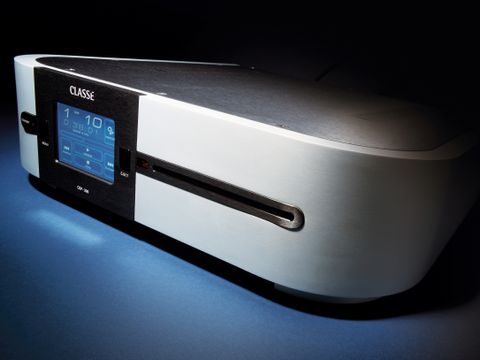Why you can trust TechRadar
Of all the prestige home cinema components, few have the pulling power of Canadian brand Classé's distinctive Delta series.
With its massive wrap-around aluminium body and touchscreen LCD front-panel controls, the Delta CDP-300 is, for many reasons, a remarkable DVD player. Aside from it's ingenious control panel, slot-loading DVD mechanism and bulletproof build quality, it is also the first player that combines an innovative LCD miniscreen and 1080p video output.
But is this enough to lure high-end buyers away from the Denon A1XVA?
At the heart of the CDP-300 is a brand new piece of high-speed silicon, the AVC2510 Dual Channel Video Format Converter from National Semiconductors. It performs the role of scaler and deinterlacer, converting all video inputs to 1920 x 1080 pixels at 50/60Hz (1080p), and back down to whatever is agreed by the HDMI handshake protocol between the player and the display screen.
A separate lower-definition video stream is available simultaneously, which feeds the LCD panel on the front of the player, though it was designed specifi cally for picture-in-picture. Analogue video processing is limited to 576i/p through the component output.
The National Semiconductor chip includes extensive contrast, edge enhancement and colour remapping, and powerful MPEG mosquito noise reduction which affects moving images, improving edge definition and chroma noise.
With a more pedestrian processor, the CDP-300 would be a lot less impressive than it is. Video D/A conversion is 12 bit, with 54x oversampling, with menu selection of interlaced and deinterlaced output from HDMI. The internal deinterlacing will almost always be superior to the deinterlacing provided by the display screen or projector.
A question of jitter
Jitter (time-based processing errors) is a recognised problem in the audio arena but less so with video. DVD players tend to suffer disproportionately due to the proliferation of clocks, with the audio master clock usually derived indirectly from the video master clock.
Here, the audio and video master clocks are entirely separate, and the audio content from all sources is upscaled to 24 bit 192kHz via a CPLD (Complex Programmable Logic Device) and sample rate converter, and re-clocked before being processed by the D/A converter.
In every respect it is an unusually sophisticated and well-executed design which, in the case of the front main stereo output pair, is internally balanced, and equipped with an XLR based balanced output, though standard phonos are also available.
The benefit of balanced operation is superior signal/noise, with reduced hum and noise pickup between the player and amplifi er which makes long leads viable. Classé's matching processor and power amplifi ers are also fully balanced, so this feature can be used throughout the complete system.
Another feature used consistently in the Delta range is the touchscreen LCD panel. This can be upgraded as required, either to accommodate particular requirements, or as the internal fi rmware is developed. It already includes features aimed at custom installers. For the very highest performance, the display can be switched off, or shown temporarily when making selections.
High performance
Performance is exceptional for a DVD player, and when used as a stereo CD player, the CDP-300 is up in the audiophile stratosphere, which is one reason why the player costs what it does. It is also an exceptional DVDAudio player in fully-fl edged multichannel trim. It breathes openly, sounds spatially expensive and musically dynamic, and offers a wealth of detail off disc.
Most readers, however, will be more interested in its video performance, and the good news is the CDP-300 excels.
Handling of motion artefacts is particularly impressive. Rapid motion of agitated water (the bow wave from power boats at the start of my newly accquired Dolby Experience demo disc) provides a remarkably good if brief example, in which every water drip is rendered with clinical, almost holographic precision, with none of the usual smudging (mosquito noise). But it is every bit as effective in scrolling end credits, where the same artefact normally introduces random flashes of colour and loss of sharpness.
The Classé is equally effective elsewhere, such as in the battle scenes from Gladiator, and the amazing action scenes from Spider Man 2.
In common with a select group of players, for example those using the Silicon Optix HQV scaler/deinterlacer (notably the A1XVA from Denon), the CDP-300 has the ability to render more detail than normal DVD decks, for example of scenes including large areas of grass, which otherwise appear homogenised, or other highly detailed scenes, and it can cope remarkably well with processing of motion.
It is a revelation after watching other DVD players. Where the Classé departs from others is in its superb handling of audio, especially legacy two channel CD, which is where is where so many players trip themselves up. Black levels are deep and pure, and scaling up to 720p (the best available using a resident Sharp XV-Z3000 DLP projector) is clean and transparent, with remarkably few artefacts.
This is what DVD is all about when executed properly. Gorgeous, beautfully built and impressively specified, the Classé is a fine wine amongst plonk.
Tech.co.uk was the former name of TechRadar.com. Its staff were at the forefront of the digital publishing revolution, and spearheaded the move to bring consumer technology journalism to its natural home – online. Many of the current TechRadar staff started life a Tech.co.uk staff writer, covering everything from the emerging smartphone market to the evolving market of personal computers. Think of it as the building blocks of the TechRadar you love today.

